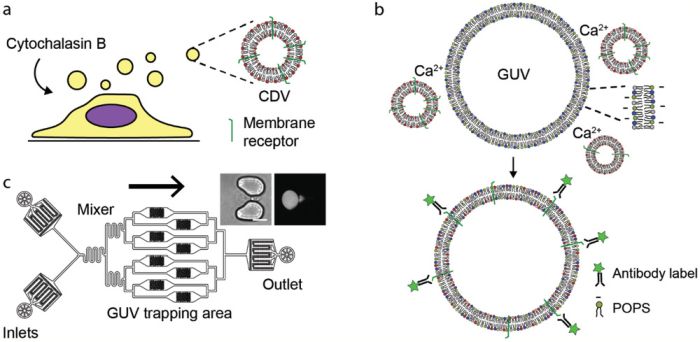
11 Nov Microfluidic reconstitution of membrane proteins into giant unilamellar vesicles: One step closer to artificial cells
Giant Unilamellar lipid Vesicles (GUVs) are lipid spherical chambers surrounded by a lipid bilayer with a size range of 1-200 micron. They are often used in artificial cells as biological membranes to recapitulate the cell wall. GUVs have been made by a wide variety of techniques including droplet microfluidics. The cell membrane includes a considerable amount of membrane-bound proteins that are necessary for cell function and signalling. The integration of membrane proteins into the GUVs’ membrane had remained a major challenge until recently ETH Zurich researchers used microfluidics to incorporate proteins in GUVs’ surface.
As seen recently in the Advanced Biosystems journal, a microfluidic chip is reported by a group of researchers at ETH that is capable of fusing cell-derived plasma membrane vesicles (CDVs) with the GUVs.
“In this work we present a detergent-free method to induce membrane fusion between GUVs and CDVs to engineer semisynthetic proteo-GUVs (“hybrid cells”). Our approach is based on calcium-induced membrane fusion. Calcium interacts with the negatively charged phospholipids, notably with phosphatidylserine (PS), which leads to aggregation and subsequent fusion of adjacent membranes.”

Reproduced under Creative Commons Attribution License. Schmid et al., Advanced Biosystems, 2010.
In order to transfer cell membrane molecules into a synthetic membrane, microfluidics fabrication techniques were employed to fuse CDVs with GUVs. The microfluidic device consisted of two inlets to introduce liposomes and calcium-containing buffer followed by a serpentine channel for mixing. Separate inlets ensured no clogging takes place. “By isolating the GUVs in microfluidic traps, we were able to avoid uncontrolled aggregation caused by millimolar concentrations of calcium. “, the authors explained. The GUVs were trapped in a microchamber to get exposed to the CDVs. The microfluidic device was designed such that the GUVs did not need to remove for fluid exchange. The GUVs contained a negative charge and therefore interacted with the calcium ions resulting in an accumulation of the CDV on GUVs and eventually fusing with the membrane.
“We believe that this system can be used to engineer fully functional hybrid liposomes, as we know from previous studies with CDVs that the functionality of the membrane proteins is preserved in the CDVs.[31, 40] While we here showed the functionality of the cytosolic protein only, future studies will focus on functionality tests of the reconstituted membrane proteins.”, the authors concluded.
Read the original article: Calcium-Mediated Liposome Fusion to Engineer Giant Lipid Vesicles with Cytosolic Proteins and Reconstituted Mammalian Proteins

Pouriya Bayat
Pouriya is a microfluidic production engineer at uFluidix. He received his B.Sc. and M.A.Sc. both in Mechanical Engineering from Isfahan University of Technology and York University, respectively. During his master's studies, he had the chance to learn the foundations of microfluidic technology at ACUTE Lab where he focused on designing microfluidic platforms for cell washing and isolation. Upon graduation, he joined uFluidix to even further enjoy designing, manufacturing, and experimenting with microfluidic chips. In his free time, you might find him reading a psychology/philosophy/fantasy book while refilling his coffee every half an hour. Is there a must-read book in your mind, do not hesitate to hit him up with your to-read list.


